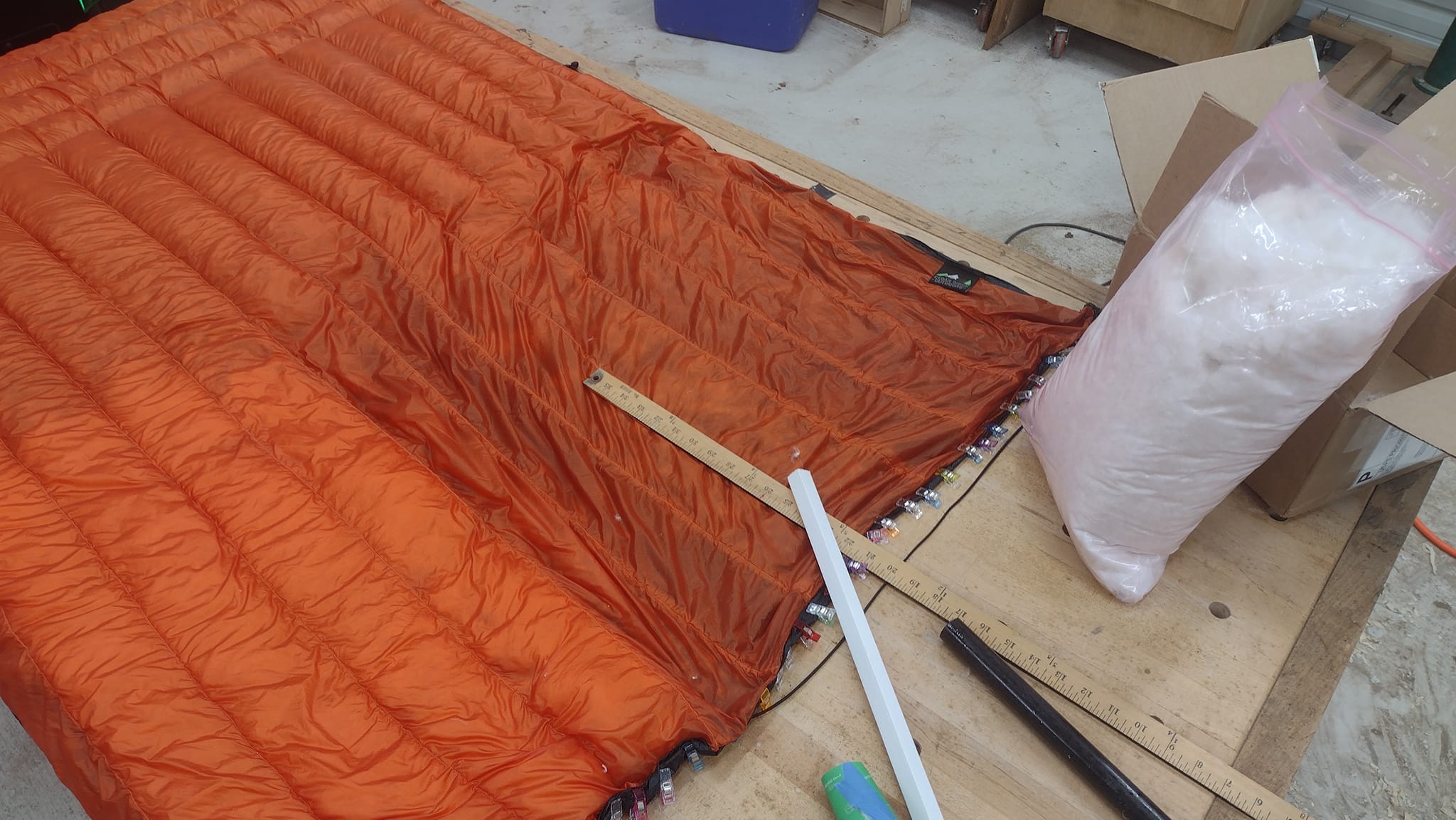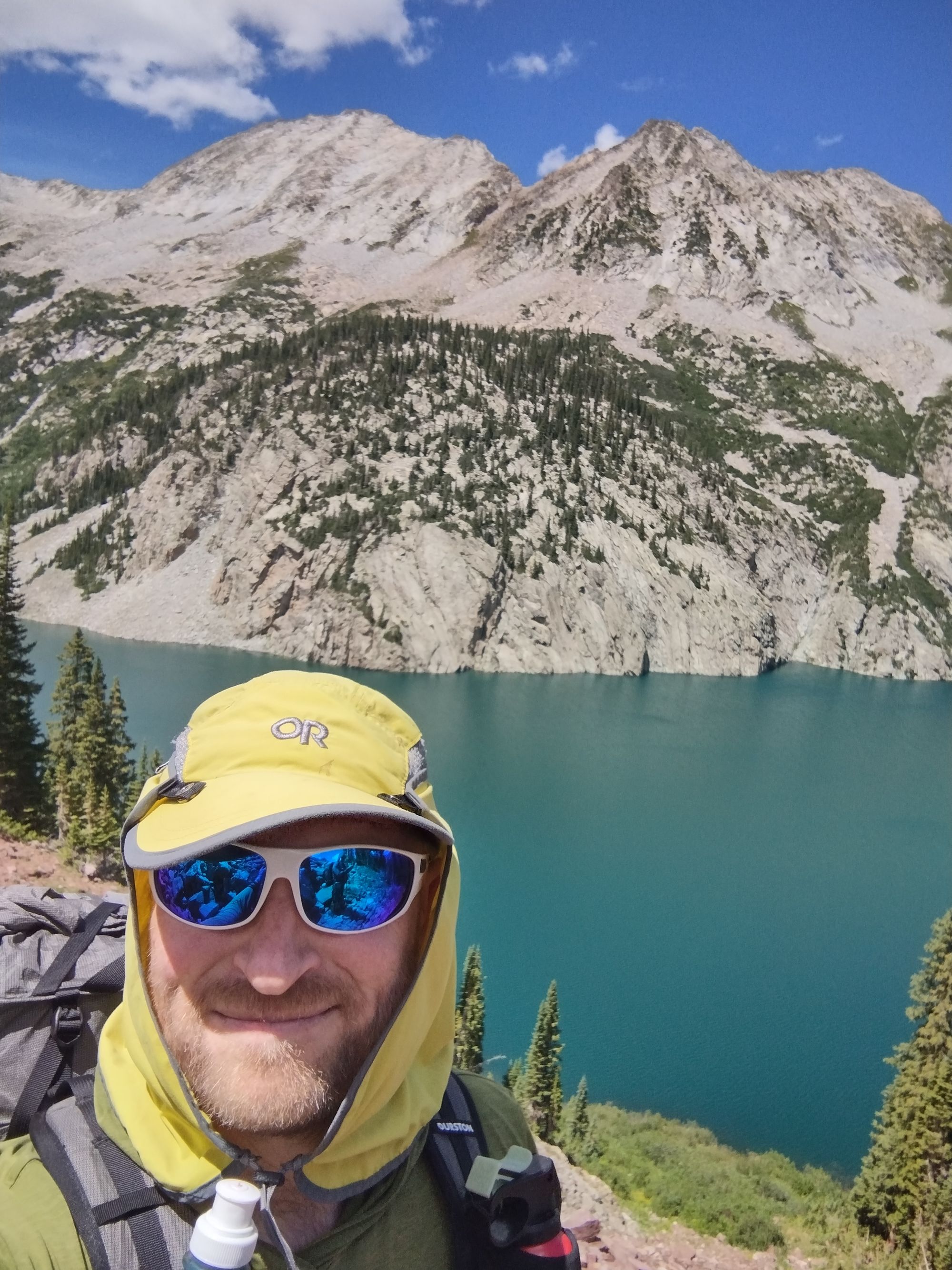Sleep System Evolution

Quilts/sleeping bags are one of the "big 4" items - those 4 items that most impact the weight and cost of most people's backpacking kit. Over time I have evolved my sleep system components, upgrading to get better/lighter versions. Today I have multiple quilts for a "mix and match" system that allows me to optimize weight for various expected conditions. But it didn't start that way.
My first sleeping bag, back in the 1970's & 80's, was one of those uber bulky, rectangular, heavy, zippered, flannel "car camping" deals. This thing was heavy, huge, and totally inappropriate for backpacking. Granted, it's what I took on my first 50-miler with my Scout troop in 1984. I was your quintessential Tenderfoot Scout. I had this sleeping bag wrapped in a plastic garbage bag strapped onto a garage-sale external frame backpack with bungie cords, which bounced as I walked down the trail. A truly pathetic site. Thankfully, after I demonstrated my love of backpacking and desire to continue doing so, my parents bought me a proper backpacking sleeping bag: An Eastern Mountain Sports 30 degree, 3-pound 6-ounce synthetic mummy bag. I still have that bag, though it is now relegated to decorative duty as a nostalgic display on my first external frame EMS backpack on my wall. But I used it for years - logging nearly 750 miles - twice completing the Vermont Long Trail, Philmont twice, and countless other trips / summer camps, etc.
When I graduated from high school, my parents gifted me the sleeping bag I had been ogling for years - a North Face 20 degree Blue Kazoo down bag that weighed less (2.4 pounds) and packed down smaller. It became my most coveted piece of backpacking kit. I took it on the Northville Placid Trail, and did a few other trips with it before I "retired" from backpacking for 25 years. It was the first thing I pulled out to rejuvenate my backpacking career in 2018 when Jordanne decided she wanted to join Scouts.
Once I rejoined the backpacking world I started learning (from YouTube) about all the gear advancements of the prior 25 years. I learned about this amazing $80, 1-pound, 40 degree bag that packed down to the size of a cantaloupe called an Aegismax. I bought one of those off Amazon and started taking it on warmer-weather trips with the Scouts here in Texas. When overnight temps were going to be between 30-40 I supplemented the Aegismax with wearing base layers and a Sea-t0-Summit liner. I learned about all the whizz-bang developments in down quilts, and started learning about the differences between various grades of down. Eventually I found a really good deal on a used Enlightened Equipment 950 fill-power 20-degree UL quilt and bought that. I rationalized that it was significantly lighter and higher quality than the old North Face bag I had. This thing was luxurious, but I soon came to realize the 20-degree ratings was marketing BS. It was really a 30 degree quilt. I took it on my 6 day December trip to Guadalupe Mountains National Park where it performed OK. If I didn't have base layers and a puffy, I would have been cold. (Temps got down in to the 20s.)
At that point I had the Northface bag, Aegismax bag, the Enlightened Equpment quilt, and a Sea to Summit liner. My use-cases were to use the liner-only for Texas hot summers, or maybe the Aegismax. I would use the liner and Aegismax combination if the temps were going to be down to about 40. I would use either the Enlightened Equipment quilt or the North Face bag if the temps were going to be 25-40, and I would use a combination if the temps were below 25 degrees, supplemented with clothing as necessary. Weights were as follows:
- Sea to Summit liner: 256 grams
- Aegismax 40-degree bag: 512 grams
- Enlightened Equipment 20- degree (really 30 degree) quilt: 573 grams
- Northface Blue Kazoo 20-degree bag: 1100 grams.
Then I got divorced and sold a house. Because I had just given away such a large chunk of money, I wanted to splurge and do something nice for myself. I posted to Reddit asking for recommendations on the warmest-per-ounce quilt out there. I wanted a true 20 degree quilt that cut the weight significantly over my options. I learned about Timmermade. Dan Timmerman engineers his quilts, sweats the details, and uses premium materials. It was expensive, but he conservatively rated his quilts, and guaranteed comfort at 20 degrees for 559 grams. So I purchased that and sold both the Enlightened Equipment quilt and the Northface bag. In conversing with Dan Timmerman, he educated me about what happens with down quilts in cold environments with water vapor condensing in the down as it migrates from your body to the outside. That moisture builds up and eventually "wets out" the down. The way to prevent that is to have an outer layer of synthetic for the moisture to condense in. Such an outer layer is easier to dry and keeps the down dry. This is achieved by having an "overbag" or "overquilt." Said overquilt could serve double duty as a light weight summer bag/quilt, and of course, Dan made them out of the best materials available. So I purchased one of those too. Weight: 387 grams.
I took the Timmermade pair to test out on a 28 degree trip. I sweat myself to death and had to vent. It was too warm. Later that winter I took just the quilt out on another trip where the temps got down to 13, and I was just starting to wish that I had the overquilt. Conclusion: The Timmermade quilt itself really is comfortable to 20. The quilt/overquilt combo is comfortable to probably about 5.
Those two trips taught me something: The Timmermade was awesome, but overkill if the temps aren't cold enough. What I really needed was a true 40-degree quilt. I could do that with the Aegismax supplemented with either the Sea-to-Summit liner or the Timmermade overquilt (768 or 899 grams.) What I really wanted was a better 40-degree quilt - i.e. one that gave me 40-degree comfort for ~400 grams, not 768-900 grams.
I could have bought a second Timmermade (and seriously considered it) but came across a company called Cedar Ridge Outdoors who also did custom, premium quilts. The had a UL offering called the "Helium" that pulled out all the stops: they used 7d fabric for the inner and outer, DCF for the baffles, and filled it with 1000(!!) fill-power down. 1000 FP down is the highest quality/lightest-per-unit-warmth available anywhere. They advertised it as "comfort" rated. A 40 degree quilt was an incredible 273 grams! I bought into the marketing hype and ordered one. I was not impressed. I have communicated with other people who also bought CRO Helium quilts. Apparently the 20-degree version really is comfortable at 20, but I'm not the only person to find the 40-degree version anemic. I found that any time the temps got below 50, I would need to layer the CRO either with the Sea-t0-Summit liner or the Timmermade overquilt. The combos worked, but the 272 gram advertised weight now became 528 or 659 grams.
At that point my mix/match lineup looked like this:
- Sea-to-Summit liner - hot Texas summer camping - temps above 75, 256 grams
- Timmermade overquilt: 60- 75, 387 grams
- CRO Helium: 50-60, 272 grams
- CRO Helium + Timmermade overquilt : 35-50, 659 grams
- Timmermade 20F quilt: 15-35: 559 grams
- Timmermade 20F quilt + overquilt, supplemented by clothing: Below 15: 946 grams
I F'd up. I should have bought a 40-degree Timmermade. That would have weighed 398 grams, or 261 grams less than the Helium + overquilt combo. I just wish the helium had more down in it. It was so thin, and if you held it up to light, you could see empty spots inside. No wonder it was cold. I posted again on Reddit asking for names of places that could rework the quilt to add more down - to fill in those blank spots. The best answer I got back was to buy some down and do it myself. So I did.
I bought 900 fill-power Hyper Dry white down from Loose Goose Down Supply. I hung the quilt for a few days and frequently shook it so all the down would settle to one end. I carefully seam ripped the seams a the end of the quilt, paying attention to how it was constructed. I watched YouTube videos to learn about down stuffing techniques, and then added 4 ounces of 900 FP and sewed it back up.



The down is now quite dense / puffy in the quilt, and not anemic at all. It's got a solid 2" loft. According to various charts, this suggests the quilt is now likely in the 25-30 degree range. Perfect! Total weight is now 391 grams, or almost exactly what Timmermade would have been. I'm still waiting to try this out.
My mix and match lineup now looks like this:
- Sea-to-Summit liner - hot Texas summer camping - temps above 75, 256 grams
- Timmermade overquilt: 60- 75, 387 grams
- CRO Helium w/MYOG mods: 35-60, 391 grams
- Timmermade 20F quilt: 15-35: 559 grams
- Timmermade 20F quilt + overquilt, supplemented by clothing: 5-15 : 946 grams
- Timmermade 20F quilt + overquilt + CRO Helium w/MYOG mods, supplemented by clothing as necessary: Below 5 degrees, 1337 grams.
Keep hiking my friends

